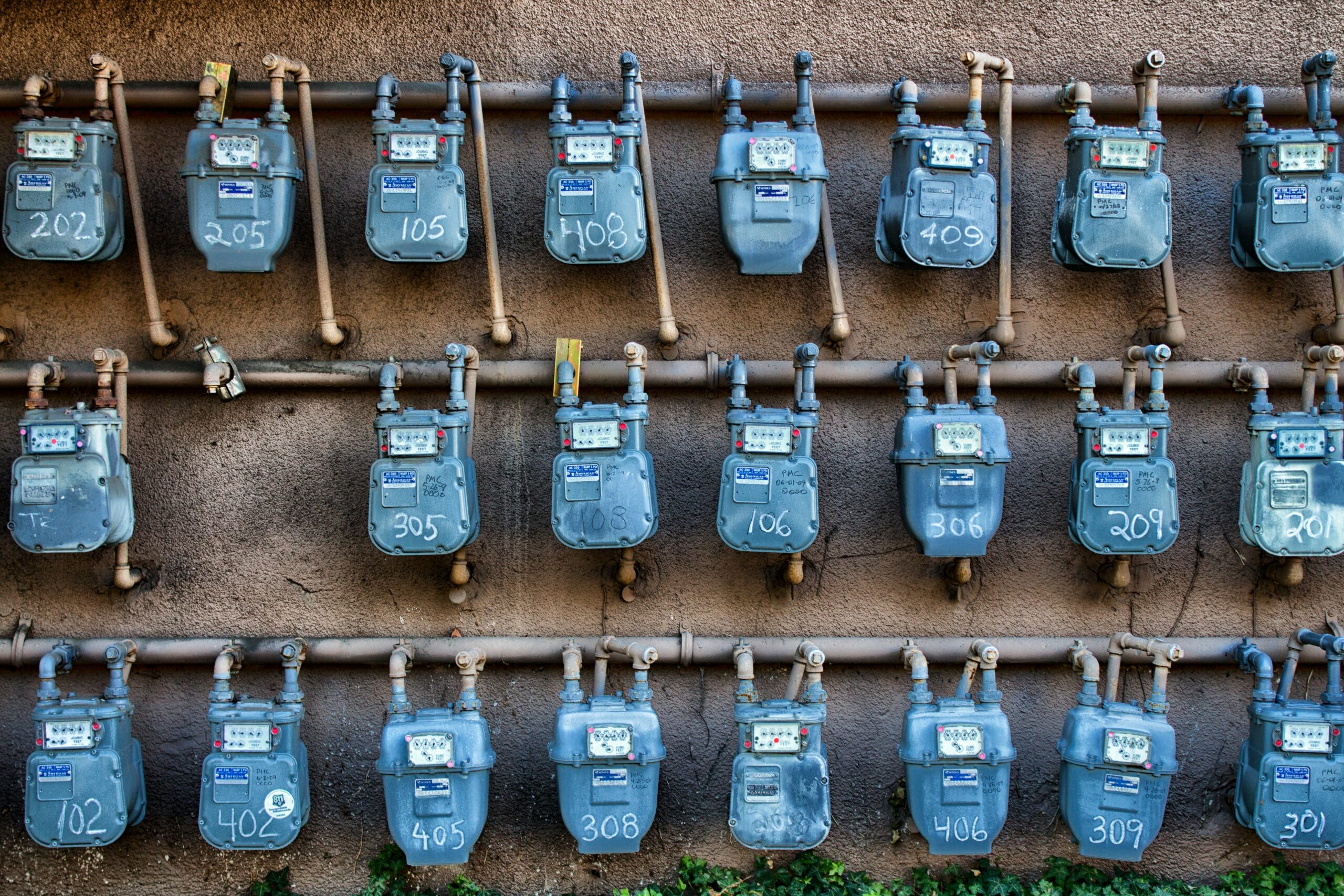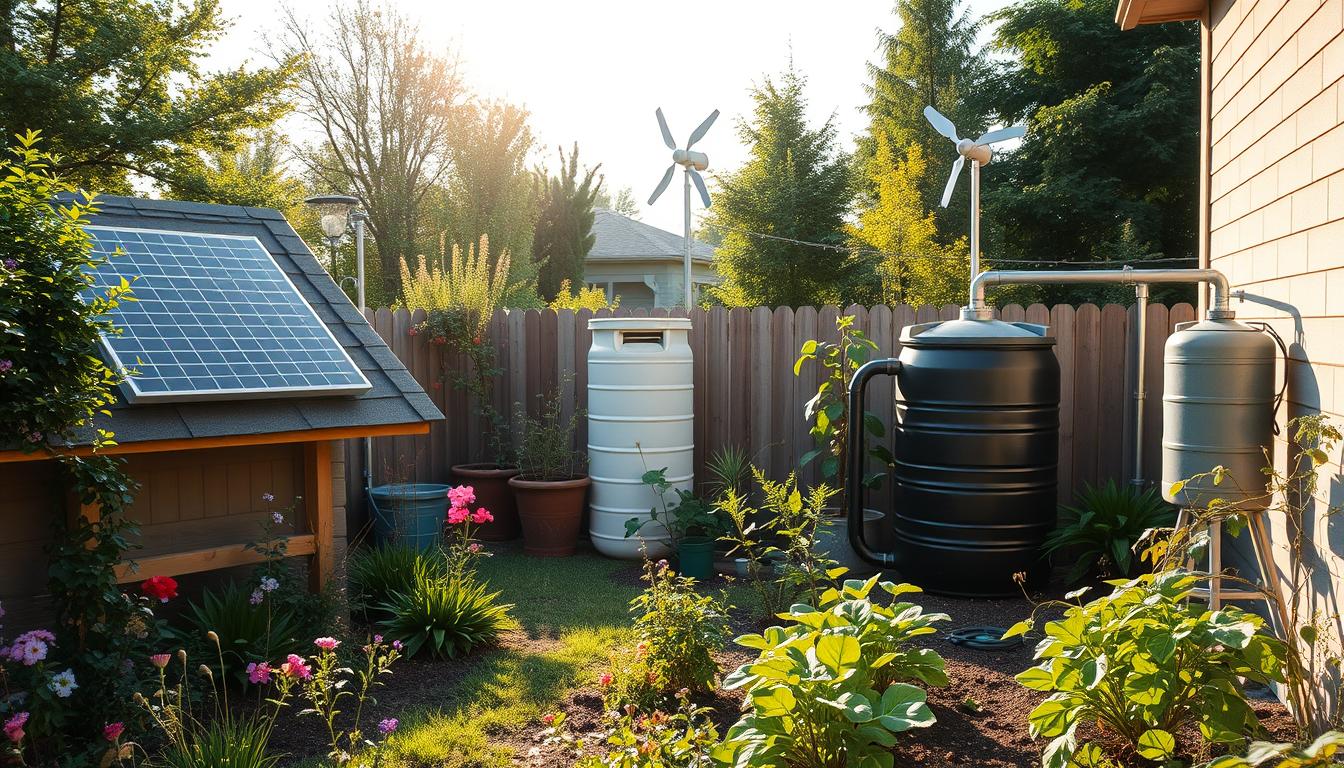When darkness falls and the power grid goes silent, panic can strike. I remember a night a severe storm left our neighborhood dark. We scrambled to find a reliable backup power solution.
Power outages are becoming more common. They make emergency power sources key for modern homes. Whether it’s extreme weather or grid issues, picking the right backup power is vital. Options like portable generators and solar power systems offer unique benefits for reliable backup power.
Choosing between portable generators and solar power depends on several factors. Costs, energy efficiency, maintenance, and environmental impact are all important. These factors help decide the best backup power solution for your home.
Key Takeaways
- Portable generators and solar power offer distinct backup power solutions
- Initial costs vary significantly between generator and solar options
- Solar systems provide more long-term environmental benefits
- Maintenance requirements differ between generator and solar technologies
- Tax incentives can offset solar power installation expenses
- Power output and capacity are key selection criteria
- Consider your specific energy needs when choosing a backup power system
Understanding Backup Power Solutions
When power goes out unexpectedly, having a backup is key to keep your home safe and comfy. Today, many people look for green power solutions to keep the lights on during emergencies.
The world of backup power has changed a lot. Now, there are many choices other than old electric generators. Knowing your options can help a lot, whether it’s bad weather or power grid problems.
Types of Emergency Power Sources
There are many kinds of emergency power solutions:
- Portable generators fueled by gasoline
- Standby generators running on propane or diesel
- Solar battery storage systems
- Hybrid renewable energy sources
The Growing Need for Reliable Backup Power
The U.S. loses over $20 billion each year because of power outages, mostly due to weather. This shows how vital it is to have strong, green energy sources.
| Power Solution | Average Cost | Operational Lifespan |
|---|---|---|
| Home Battery System | $10,000 – $20,000 | 10+ years |
| Standby Generator | $7,000 – $15,000 | 20 years (with maintenance) |
| Solar Battery Storage | From $10,000 | 10+ years |
Impact of Power Outages on Daily Life
“Backup power isn’t a luxury—it’s a necessity in today’s unpredictable environment.”
Power cuts can mess up important services and make communication hard. They also pose safety risks. Choosing the right generator or solar system keeps your home running when the grid fails.
Going for solar power systems is a smart, green choice. It’s reliable and good for the planet.
How Portable Generators Work
Portable generators are key for backup power when you need it. They come in various sizes and types. This means you can find the perfect one for your needs, from small to whole-home systems.
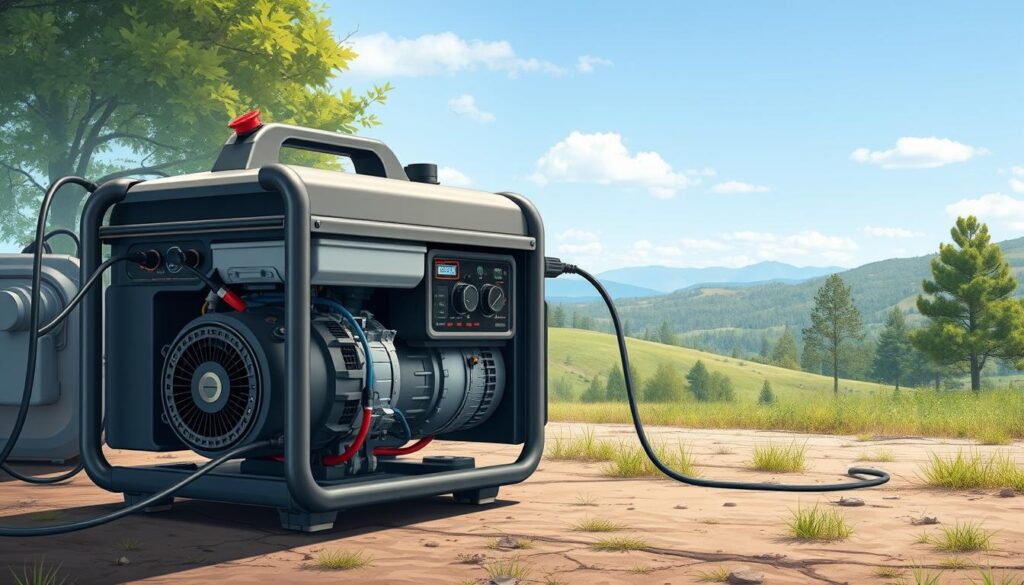
Portable generators turn mechanical energy into electrical power. Fuel-powered generators use propane, natural gas, or diesel. They start up during outages, keeping your important appliances running.
- Power output ranges from 3,000 to 8,000 watts for portable units
- Standby generators provide 10,000 to 20,000 watts
- Cost varies from $500 to $2,000 for portable gas generators
“A portable generator is your lifeline during unexpected power interruptions, providing critical electricity when you need it most.”
Standby generators are a step up with automatic start during outages. They have sensors that turn on when power goes out. This makes them great for those who want power without interruption.
| Generator Type | Power Output | Typical Cost Range |
|---|---|---|
| Portable Generators | 3,000 – 8,000 watts | $500 – $2,000 |
| Standby Generators | 10,000 – 20,000 watts | $5,000 – $18,000 |
When picking a portable generator, think about your power needs. Look at wattage, fuel type, and size. This will help you find the best one for your home or outdoor use.
Solar Power Systems: Core Components and Operation
Solar power systems are a new way to get clean energy for homes and businesses. They use sunlight to make electricity, a better choice than old power sources.
Today’s solar systems are made with care. They have key parts that work together to catch, store, and use the sun’s energy. Knowing about these parts helps you choose the right solar tech.
Solar Panels: The Energy Collection Powerhouse
Solar panels are the main way to get solar energy. They use special cells to turn sunlight into electricity. They have:
- The power to make electricity from sunlight
- Different sizes and strengths for various needs
- Long-lasting against weather
- Can work even when it’s not fully sunny
Battery Storage Systems: Powering Your Future
Battery backups keep extra energy from solar panels. They make sure you have power when it’s dark or not sunny. Some top choices are:
- Tesla Powerwall
- Enphase battery systems
- Panasonic energy storage
- Generac power reserves
Inverters: Transforming Energy for Home Use
Inverters are key in solar systems. They change the direct current from solar panels into alternating current for homes. Today’s inverters have:
- Efficient power change
- Smart tracking features
- Better system performance tracking
- Many connection options
“Solar power systems transform sunlight into a reliable, clean energy source for modern living.” – Energy Innovation Expert
Choosing a full solar power system means you’re going green. It cuts down on carbon and gives you clean energy for your place.
Initial Costs and Long-term Investment Comparison
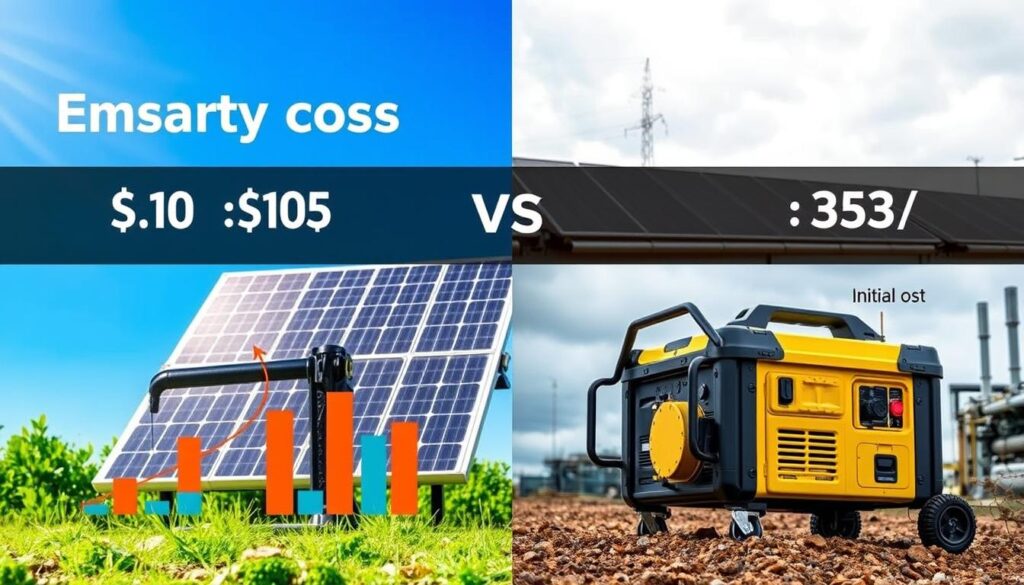
When looking at backup power options, knowing the costs is key. Your first investment affects your long-term energy savings and efficiency.
Portable generators and solar power systems have different costs. It’s important to look at both:
- Gas generators cost between $500 to $7,500
- Portable solar generators start at $1,000
- Full solar power systems cost between $25,000 to $30,000
Solar solutions might seem pricey at first. But, they offer big savings over time. You’ll save on electricity bills and might get tax breaks too.
| Power Solution | Initial Cost | Operational Expenses | Long-term Savings |
|---|---|---|---|
| Gas Generator | $500 – $7,500 | High (Fuel, Maintenance) | Limited |
| Solar System | $25,000 – $30,000 | Minimal | Significant |
“Investing in solar is not an expense, but a long-term financial strategy” – Clean Energy Expert
Your choice depends on your budget now and your energy goals later. Generators are cheaper upfront, but solar is better for saving money in the long run.
Portable Generator vs. Solar Power: Key Differences
Choosing a backup power solution means knowing the key differences between portable generators and solar power. Each has its own benefits and drawbacks. These can affect how reliable your power is and the impact on the environment.
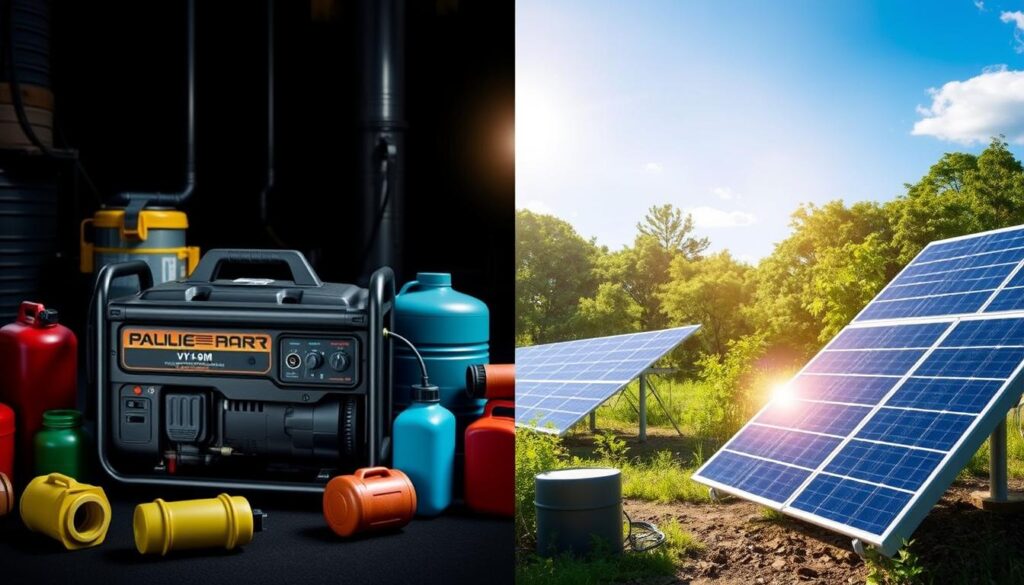
Power Output and Capacity
Portable generators and solar power systems have different power capacities. For example, the EcoFlow DELTA Pro has 3600Wh, enough to power household items. Solar power systems, on the other hand, offer more flexibility:
- EcoFlow DELTA Mini: 24 lbs, compact design
- EcoFlow RIVER 2: 256Wh capacity, charges most electronic devices
- EcoFlow DELTA Pro Solar Generator: Expandable up to 25kWh
Fuel Dependencies and Energy Sources
Fuel dependency is a big difference between these options. Traditional generators use fossil fuels, which can be affected by supply chain issues and price changes. Solar power systems, on the other hand, use renewable energy, making them more independent.
“Solar generators offer a sustainable alternative to fossil fuel-dependent power sources.” – Energy Innovations Research Group
Environmental Impact Considerations
The environmental impact of your choice is important. Solar generators have zero direct emissions, operate silently, and have a low carbon footprint. Portable generators, while effective, produce noise and greenhouse gases.
| Feature | Portable Generator | Solar Power System |
|---|---|---|
| Emission Level | High | Zero |
| Noise Output | Significant | Silent |
| Renewable Energy | No | Yes |
Your decision depends on your needs, budget, and environmental concerns. Solar power systems are great for long-term sustainability. Portable generators provide quick, strong power solutions.
Maintenance Requirements and Operational Costs
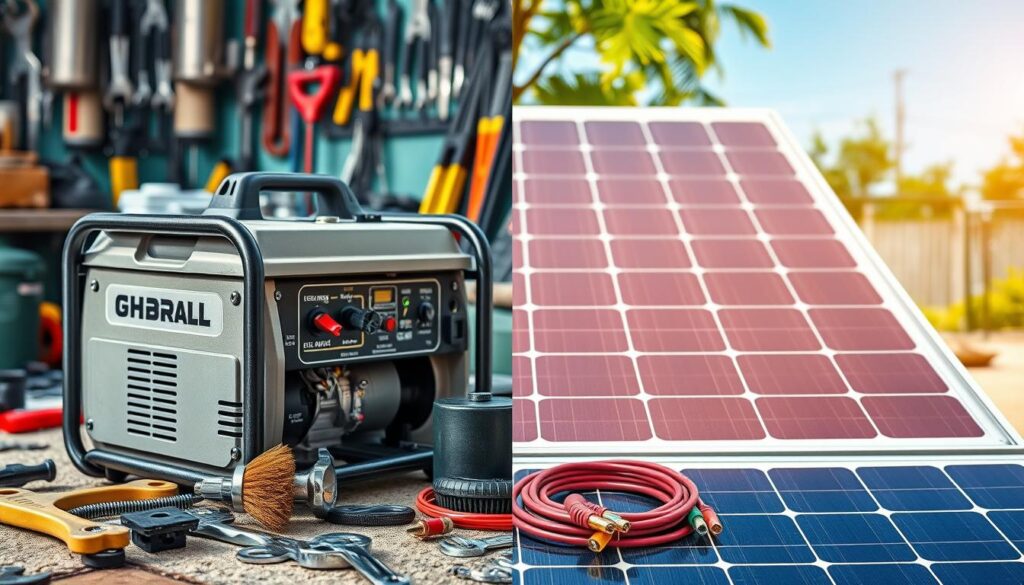
When looking at backup power options, knowing about maintenance and operational costs is key. Portable generators and solar systems have different needs that affect their costs over time.
Generator Maintenance Breakdown
Gas generators need a lot of upkeep. You’ll spend money on regular care that can add up fast. Important maintenance tasks include:
- Weekly self-testing procedures
- Annual professional servicing
- Fuel stabilization
- Regular oil and filter changes
Fuel costs are a big part of owning a traditional generator. A mid-sized gas generator uses 5 gallons, costing $500-$1,000 a year. Gas also goes bad in 3-6 months, making upkeep harder.
Solar Power Operational Costs
Solar generators have a different cost picture. They need little to no upkeep and no fuel costs, making them more budget-friendly. You can also get up to 30% off the initial cost with federal incentives.
| Cost Factor | Gas Generator | Solar Generator |
|---|---|---|
| Initial Purchase | $500-$1,000 | $600-$1,000 |
| Annual Maintenance | $300-$800 | $0-$50 |
| Fuel/Energy Costs | $500-$1,000/year | $0 |
“The true cost of a power solution isn’t just its purchase price, but its lifetime operational expenses.” – Energy Efficiency Expert
Choosing between portable generators and solar power depends on these costs. While the upfront costs are different, solar might be cheaper in the long run.
Environmental Impact and Sustainability
When picking backup power, knowing its environmental effect is key. Choosing between portable generators and solar power affects your carbon footprint and sustainability.
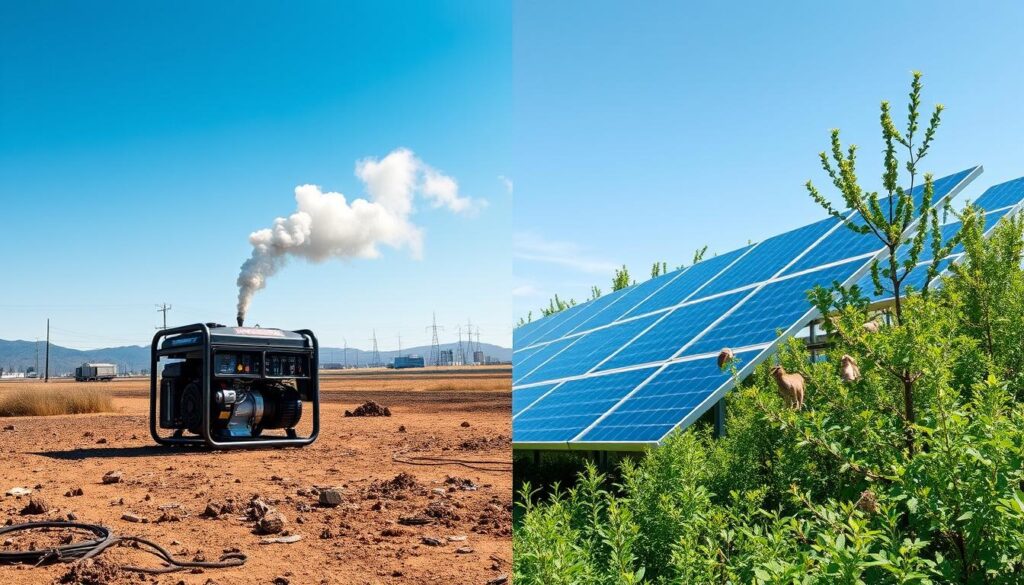
Carbon Footprint Analysis
Traditional fuel generators harm the environment a lot. They release a lot of CO2 and pollutants, causing air pollution and climate change. Diesel generators, in particular, have higher carbon emissions than other fuels.
- Diesel generators emit up to 22% more CO2 than petrol generators
- Fuel generators release direct pollutants into the atmosphere
- Continuous generator use accelerates environmental degradation
Renewable Energy Benefits
Solar power systems are a big step towards sustainable energy. They use sunlight to make zero direct emissions, greatly lowering your environmental impact.
| Energy Source | CO2 Emissions | Environmental Impact |
|---|---|---|
| Diesel Generator | High | Significant pollution |
| Solar Generator | Zero | Minimal environmental disruption |
Long-term Environmental Considerations
Renewable energy is more than just a quick fix. Solar power helps meet global sustainability goals by cutting down on fossil fuel use and promoting clean energy.
“The future of power generation lies in renewable, environmentally conscious solutions.” – Clean Energy Institute
By picking solar generators, you meet your power needs and help cut down greenhouse gas emissions. You’re also supporting a greener future.
Reliability and Performance in Different Conditions
Choosing a backup power solution means looking at how systems work in various weather. You have to pick between portable generators and solar power systems. Each has its own strengths and weaknesses.
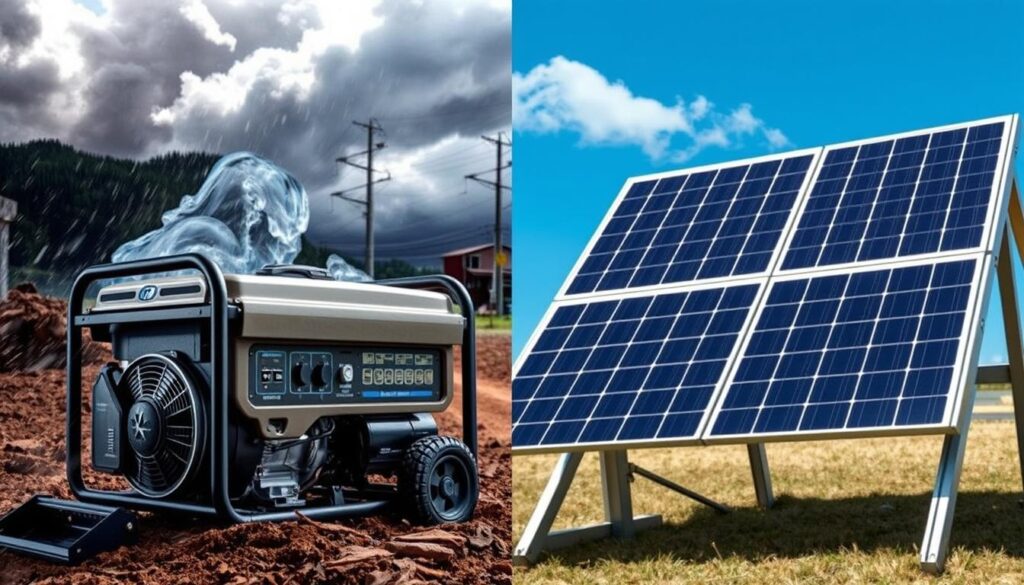
Portable generators and solar power systems each have their own benefits. Generators start working fast when power goes out. Solar systems, though, are a greener way to handle energy needs.
- Generators deliver instant power across diverse weather conditions
- Solar systems perform best with consistent sunlight exposure
- Battery storage helps mitigate intermittent solar energy production
Weather affects both options. Generators keep going as long as you have fuel. Solar systems need sunlight and stored energy. Lithium-ion batteries are now the top choice for storing energy, thanks to their reliability and performance.
| Performance Metric | Portable Generators | Solar Battery Systems |
|---|---|---|
| Power Output | High, immediate | Dependent on battery capacity |
| Weather Resilience | Consistent | Variable |
| Noise Level | High | Silent |
| Environmental Impact | High emissions | Low carbon footprint |
“Energy resiliency is about choosing a solution that meets your specific power needs reliably and efficiently.” – Energy Experts
Your environment, energy needs, and budget will decide the best backup power. It’s all about finding the right fit for your situation.
Installation Process and Requirements
Setting up a power backup system needs careful planning and skill. Whether you’re looking at solar power or a portable generator, knowing what’s needed is key. This ensures your system works well and safely.
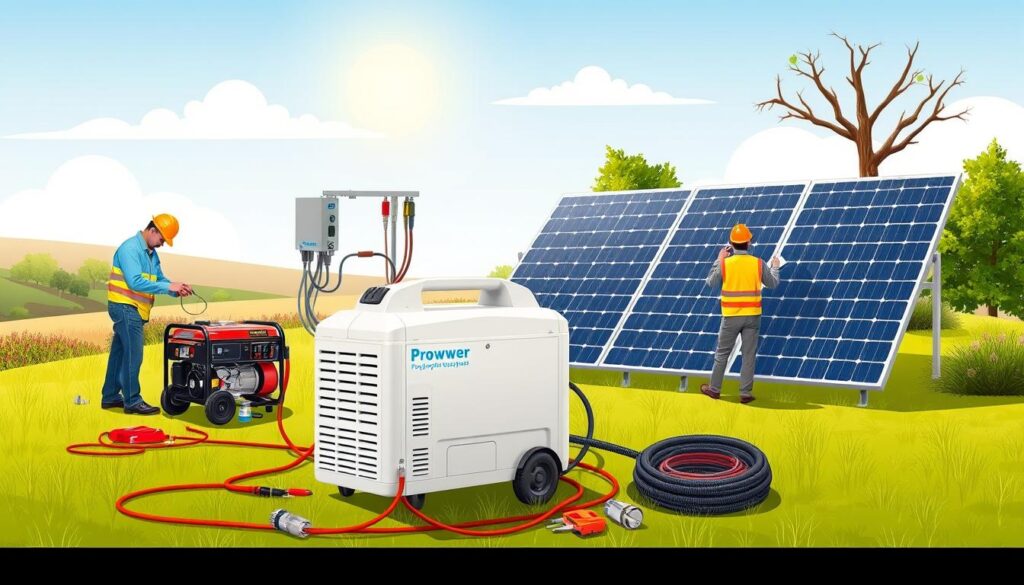
The success of your power backup system depends on several important factors during installation. Getting a pro to do the job is vital. They can handle the electrical setup and local rules.
Site Preparation
Getting your site ready involves a few key steps:
- Check how much space you have for the equipment
- Make sure the ground is sturdy and level
- See how close it is to your electrical panel
- Make sure there’s enough air flow
Professional Installation Needs
Hiring a pro for your power backup system has many benefits. Certified techs know all about the installation needs. They can:
- Connect the electrical systems right
- Put in the right transfer switches
- Place the system where it works best
- Make sure it meets all the rules
Permits and Regulations
Local rules are very important for installing power systems. Each area has its own rules that affect your project.
| Type of System | Typical Permit Requirements | Average Processing Time |
|---|---|---|
| Solar Power System | Electrical and building permits | 2-4 weeks |
| Portable Generator | Zoning and noise compliance permits | 1-3 weeks |
“Proper installation is not an expense, but an investment in reliable power backup.”
Costs for professional installation can range from $500 to $3,000, depending on system complexity and local market rates. Always talk to licensed pros who know the local rules. They can handle the complex setup needs for your power backup solution.
Available Incentives and Tax Benefits
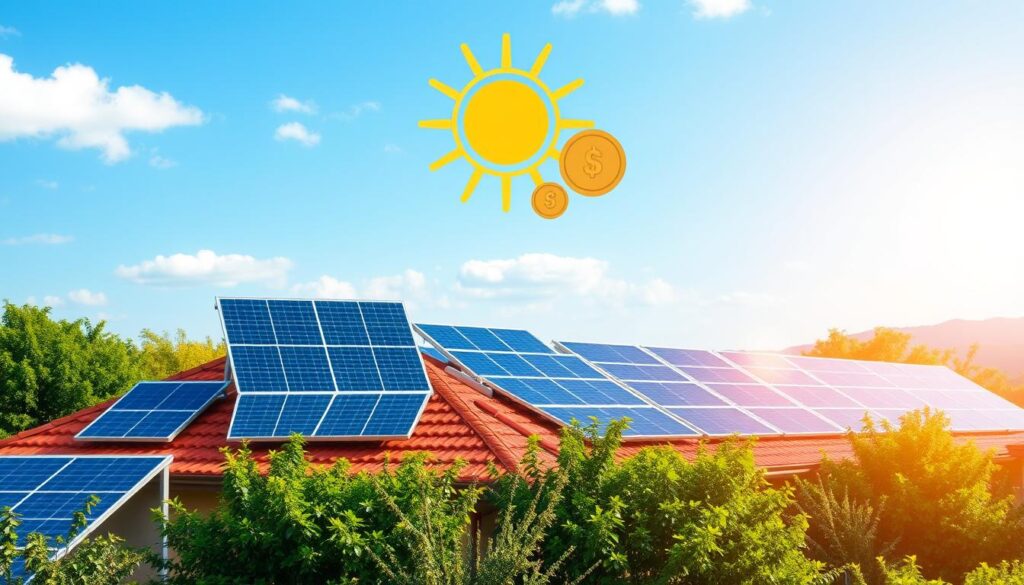
Thinking about solar power or generator systems? Knowing about tax incentives and government programs can help lower your costs. The federal government and many states offer financial help for renewable energy.
“Investing in solar power isn’t just an environmental choice—it’s a smart financial decision with substantial government support.”
The biggest tax incentive for solar power is the federal solar tax credit. It lets you deduct a big part of your solar installation costs from your federal taxes. Plus, state rebates can give you more savings.
- Federal Solar Investment Tax Credit (ITC): Up to 30% of installation costs
- State-specific solar rebates vary by location
- Local utility company incentive programs
- Performance-based incentives for solar energy production
Each region has its own programs to boost renewable energy use. For example, California’s SGIP Equity Resiliency program helps with battery storage in areas that often lose power.
| Incentive Type | Potential Savings | Eligibility |
|---|---|---|
| Federal Tax Credit | Up to 30% of costs | Solar installations |
| State Rebates | $500-$5,000 | Varies by state |
| Utility Incentives | Performance-based | Grid-connected systems |
Pro tip: Always talk to a tax expert to get the most from tax incentives. They can help you understand what programs you qualify for in your area.
Lifespan and Warranty Considerations
When you buy backup power solutions, knowing about equipment lifespan and warranty is key. Different power systems last longer and offer better protection. This affects your investment a lot.
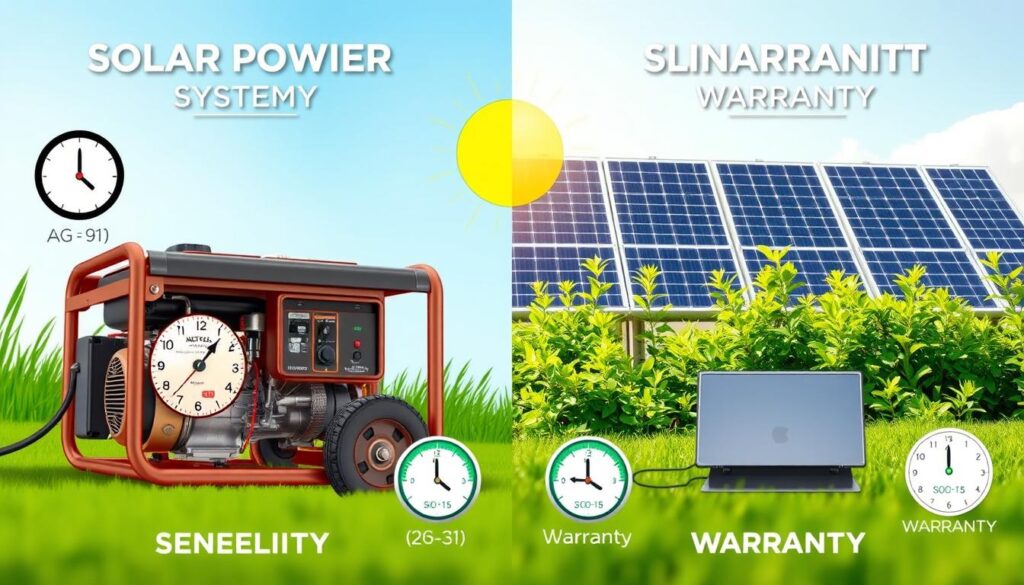
Solar battery systems usually have stronger warranties than traditional generators. For example, Tesla warranties its batteries to keep 70% capacity after 10 years. This shows a strong commitment to lasting reliability, unlike gas-powered systems.
- Solar batteries: 10-15 year warranty
- Fuel generators: 1-3 year warranty
- Potential operational lifespan: 20 years with proper maintenance
Keeping your power system in good shape is important. Solar generators need little care, like cleaning and checking parts sometimes. But gas generators need more work, like oil changes and filter swaps.
- Regular oil changes
- Filter replacements
- Fuel system management
“Investing in a reliable backup power system is about understanding not just initial costs, but long-term performance and protection.” – Energy Research Institute
Choosing between solar and gas power depends on warranty, usage hours, and upkeep. Good generators can run for 3,000 hours. Solar batteries manage energy well and might cost less over time.
| Discover the Hidden Power of Edison’s ‘Lost Invention’ As we’ve explored the benefits and drawbacks of portable generators and solar power, one thing is clear: the search for a reliable, sustainable, and cost-effective energy source continues. But what if there was an alternative that could provide unlimited energy on demand without the hassle of fuel or solar panels? Thomas Edison’s ‘Lost Invention’ holds the key to unlocking a limitless energy supply for your home or business. This groundbreaking technology, which has been buried in history for decades, could revolutionize the way we think about energy generation. Ready to discover the secret behind Edison’s incredible invention? Click here to learn how this lost technology can change the way you power your life forever. |
Conclusion
Choosing the right backup power solution is important. You need to think about your energy goals and future plans. Your choice between portable generators and solar power depends on your needs, budget, and the environment.
Solar generators have big benefits. They don’t pollute and last 6-10 years. They use sunlight and come with a 26% federal tax credit, making them a smart choice for the long run. Gas generators, on the other hand, are louder and cost more to run.
Think about what you need now and what you’ll need in the future. Look at power capacity, environmental impact, and cost over time. Brands like Jackery show how solar tech can be efficient, with panels up to 25% efficient and power stations that charge many devices.
Investing in a good backup power system makes your energy more reliable. Whether you want quick power or green energy, knowing your needs helps you choose the best option for constant power.
FAQ
What are the main differences between portable generators and solar power systems?
Portable generators use fossil fuels like propane or diesel. They give power right away when the power goes out. Solar power systems, on the other hand, use sunlight to make electricity. They store extra power in batteries.
Generators cost less upfront but more to run. Solar systems cost more at first but save money over time. Plus, they’re better for the environment.
How long can portable generators and solar battery systems provide power during an outage?
Generators keep running as long as you have fuel. Solar systems can recharge during the day. How long they last depends on how much power you use and how big your system is.
Generators usually last longer without stopping. Solar systems give clean energy and can recharge during the day.
Are solar power systems more environmentally friendly than generators?
Yes, solar systems are much better for the planet. They make no pollution and use clean energy. Generators, on the other hand, burn fossil fuels and pollute the air.
Solar systems help fight climate change. They’re a key part of sustainable energy.
What are the typical costs for portable generators versus solar battery systems?
Generators cost between
FAQ
What are the main differences between portable generators and solar power systems?
Portable generators use fossil fuels like propane or diesel. They give power right away when the power goes out. Solar power systems, on the other hand, use sunlight to make electricity. They store extra power in batteries.
Generators cost less upfront but more to run. Solar systems cost more at first but save money over time. Plus, they’re better for the environment.
How long can portable generators and solar battery systems provide power during an outage?
Generators keep running as long as you have fuel. Solar systems can recharge during the day. How long they last depends on how much power you use and how big your system is.
Generators usually last longer without stopping. Solar systems give clean energy and can recharge during the day.
Are solar power systems more environmentally friendly than generators?
Yes, solar systems are much better for the planet. They make no pollution and use clean energy. Generators, on the other hand, burn fossil fuels and pollute the air.
Solar systems help fight climate change. They’re a key part of sustainable energy.
What are the typical costs for portable generators versus solar battery systems?
Generators cost between $1,413 and $7,594. Installation can add $10,000 or more. Solar systems start at $9,000, with total costs from $25,000 to $30,000.
Even though solar systems cost more upfront, they save money in the long run. They also might get you tax breaks.
Do solar battery systems work during cloudy or stormy weather?
Solar systems work on cloudy days, but not as well. They store energy from sunny days. This way, you can use it when it’s not sunny.
Some systems can also use grid power or generators. This ensures you always have power, even when it’s not sunny.
What maintenance is required for generators and solar power systems?
Generators need regular checks and fuel management. Solar systems need little maintenance, just occasional cleaning and checks.
Generators cost more to run and might need repairs. Solar systems are cheaper to run and need less maintenance.
Are there any government incentives for installing solar battery systems?
Yes, solar systems get government help. The federal solar tax credit can lower costs. Some states offer rebates, too.
Programs like California’s SGIP Equity Resiliency program give extra help. Generators don’t get these incentives.
How long do solar battery systems and generators typically last?
Solar batteries usually last 10 years, keeping 70% of their power. Generators can last up to 20 years if well-maintained.
Solar systems often have longer warranties. Generators might need more parts or even a new unit over time.
,413 and ,594. Installation can add ,000 or more. Solar systems start at ,000, with total costs from ,000 to ,000.
Even though solar systems cost more upfront, they save money in the long run. They also might get you tax breaks.
Do solar battery systems work during cloudy or stormy weather?
Solar systems work on cloudy days, but not as well. They store energy from sunny days. This way, you can use it when it’s not sunny.
Some systems can also use grid power or generators. This ensures you always have power, even when it’s not sunny.
What maintenance is required for generators and solar power systems?
Generators need regular checks and fuel management. Solar systems need little maintenance, just occasional cleaning and checks.
Generators cost more to run and might need repairs. Solar systems are cheaper to run and need less maintenance.
Are there any government incentives for installing solar battery systems?
Yes, solar systems get government help. The federal solar tax credit can lower costs. Some states offer rebates, too.
Programs like California’s SGIP Equity Resiliency program give extra help. Generators don’t get these incentives.
How long do solar battery systems and generators typically last?
Solar batteries usually last 10 years, keeping 70% of their power. Generators can last up to 20 years if well-maintained.
Solar systems often have longer warranties. Generators might need more parts or even a new unit over time.
Source Links
- Solar Battery vs. Generator: Which One Is Right for You? | Boston Solar | MA
- Solar Generators Vs. Solar Systems: Which Are Better?
- Batteries or Generators: Which Backup Power Source Is Best for Your Home?
- A Home Backup Generator or Solar Battery?
- Backup Generator vs Battery Storage for Power Outages
- Solar vs. Gas Generators: Which Backup Power Option Is Best for You?
- Solar Generators Vs. Solar Systems: Which Are Better?
- Solar Generators: A Guide to Portable Solar Power
- Solar Generators Vs. Solar Systems: Which Are Better?
- Portable Solar Generators vs. Gas Generators: Which One is Right for You?
- Solar Generators Vs. Solar Systems: Which Are Better?
- Portable Power Station vs. Solar Generators: The Differences
- Solar Generator vs. Portable Power Station vs. Solar Panel: What is the Difference – Jackery
- What’s Better for Backup Power? Solar or Gas Generators?
- Solar Battery vs. Generator: Which One is Best for My Home? — Sandbar Solar & Electric
- Solar vs. Generator: Selecting the Ideal Backup Solution for Your Specific Requirements
- Solar Generators vs. Gas Generators | WHC SOLAR
- Portable Solar Generators – The Key to Sustainable Energy in Remote Areas
- Are Portable Generators Sustainable? | Green City Times
- Solar Panels Vs Generators | Sun Source Energy
- Solar battery VS Generator: Which is Better for Your Home?
- Solar Generator or Solar Battery For Your House?
- Solar Generators Vs. Solar Systems: Which Are Better?
- Solar Generator vs. Portable Power Station vs. Solar Panel: What is the Difference – Jackery
- Solar + Storage vs. Generators in the United States
- Generators vs. Solar Power Systems | Tri-State Water, Power & Air
- Solar vs Gas Generators: Which Should Power Your Home?
- Solar Battery or Generator for Emergency Backup Power? – Jamar Power Systems
- Whole House Battery Backup Vs Generators (2024) | 8MSolar
- Portable Solar vs. Gas Generators: Your Ultimate Guide
- Solar Generator vs. Portable Power Station vs. Solar Panel: What is the Difference – Jackery
Affiliate Disclosure: This article contains affiliate links, meaning I may earn a commission if you click through and make a purchase, at no extra cost to you.


